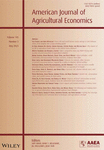
Uniquement disponible en anglais.
Publication de l’article Structural identification of weather impacts on crop yields: Disentangling agronomic from adaptation effects par François Bareille et Raja Chakir dans la revue American Journal of Agricultural Economics.
Volume 105, Issue 3, May 2023
https://doi.org/10.1111/ajae.12420
A large literature has assessed the impacts of climate change on agricultural production by estimating reduced-form models of crop yields conditionally on weather and individual fixed effects. The estimates obtained are usually interpreted as the weather impacts on yields once farmers have adapted. Yet, few attempts have documented that farmers do adapt to weather, and none have verified that these adjustments actually impact crop yields. Our objective here is to unpack how weather affects agricultural production by developing a structural model that explicitly accounts for both the plants’ biophysical and farmers’ behavioral responses to weather. Considering adaptation during the growing season through fertilizer and pesticide applications, our approach allows us to distinguish the “direct” weather effects (i.e., the agronomic impacts of weather changes on plant growth per se) from the “indirect” weather effects via farmers’ input choices (i.e., the adaptation impacts). We estimate the underlying structural model using farm-level data from the Meuse French department, which provides details of fertilizer and pesticide uses by crop. We show that the reduced-form and structural estimates indicate similar weather impacts on crop yields, for a large range of sensitivity analyses. Our structural estimates indicate that the adaptation effects are sizable and that farmers’ adjustments reduce projected damage from climate change. In our illustrative case, farmers’ adaptation offsets between one-quarter to two-thirds of the negative agronomic impacts of future warming on crop yields. Our analyses exhibit that commonly used reduced-form models of crop yields inherently capture these within-season behavioral responses to weather.

